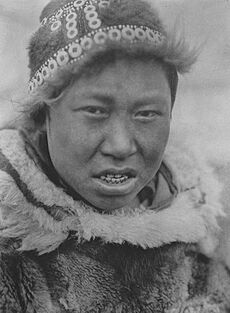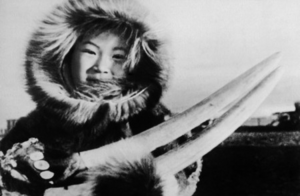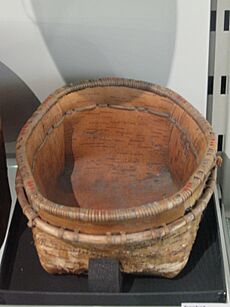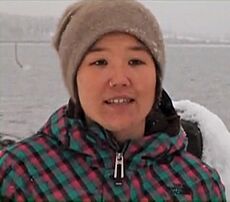Yupik peoples facts for kids
| Total population | |
|---|---|
| ~35,567 | |
| Regions with significant populations | |
| United States Alaska |
33,889 22,000 |
| Russia Chukotka |
~1,700 |
| Languages | |
| English (Alaska) • Russian (in Siberia) • Yupik languages | |
| Religion | |
| Christianity (mostly Eastern Orthodox and Moravian), Shamanism, Atheism | |
| Related ethnic groups | |
| Aleut, Chukchi, Inuit, Iñupiat, Sirenik | |
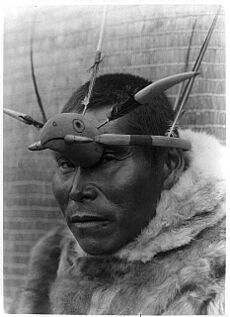
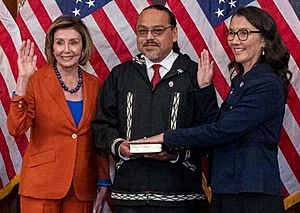
The Yupik (Russian: Юпикские народы) are a group of Native people. They live in western, southwestern, and southcentral Alaska. They also live in the Russian Far East. The Yupik are related to the Inuit and Iñupiat peoples.
There are different groups of Yupik people:
- The Alutiiq, or Sugpiaq, live on the Alaska Peninsula and islands in southcentral Alaska.
- The Yupʼik or Central Alaskan Yupʼik live in the Yukon–Kuskokwim Delta and along the Kuskokwim River.
- The Siberian Yupik live in the Russian Far East and on St. Lawrence Island in western Alaska. This group includes the Naukan and Chaplino.
Contents
Who are the Yupik People?
The Yupik people are the largest group of Alaska Natives. Most of them speak the Central Alaskan Yupʼik language. This language is part of the Eskaleut family.
In 2002, over 24,000 Yupik people lived in the United States. More than 22,000 of them lived in Alaska. They mostly live in about 70 communities in their traditional lands. This area is in western and southwestern Alaska. About 1,700 Yupik people also live in Russia.
What Does "Yupik" Mean?
The word Yupʼik (plural Yupiit) comes from their own language. It combines yuk, meaning "person," and -pik, meaning "real" or "genuine." So, Yupʼik means "real people."
In some Yupʼik dialects, like Hooper Bay-Chevak and Nunivak, the people and their language are called Cupʼik. The apostrophe in "Yupʼik" shows that the "p" sound is longer.
Where Did the Yupik Come From?
Scientists believe the ancestors of the Yupik and Aleut came from eastern Siberia. They arrived in the Bering Sea area about 10,000 years ago. They crossed a land bridge called Beringia. This bridge connected Siberia to North America when sea levels were lower.
Around 3,000 years ago, the Yupik ancestors settled along the coast of what is now western Alaska. They later moved up rivers like the Yukon and Kuskokwim. This happened around 1400 AD.
Yupik Culture and Traditions
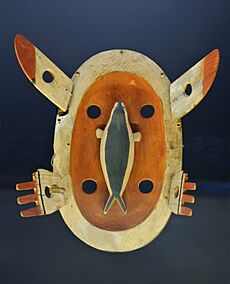
Traditionally, Yupik families spent spring and summer at fish camps. They would then gather in villages for the winter. Many families still hunt and fish for their food today. They especially rely on Pacific salmon and seals.
The qasgiq was a special house for men. It was the community center for events like singing, dancing, and storytelling. The qasgiq was used mostly in winter. During warmer months, people traveled to find food. In the qasgiq, men taught young boys how to survive and hunt. They also learned how to make tools and qayaq (kayaks).
The women's house, called the ena, was usually next to the qasgiq. Sometimes, they were connected by a tunnel. Women taught young girls how to prepare animal hides and sew. They also learned to cook game and fish, and how to weave. Boys lived with their mothers until they were about five years old. Then, they joined the men in the qasgiq.
For a few weeks each year, boys and girls would switch teachers. Men would teach girls survival and hunting skills. Women would teach boys the skills they taught to girls.
In Yupʼik dances, people often move their upper body and arms. They hold dance fans, which look like Cherokee dance fans. The dances can be graceful, energetic, or funny.
The Yupik have a unique tradition. They name children after the most recent person in the community who has passed away.
The kuspuk (qaspeq) is a traditional Yupʼik piece of clothing. Both men and women wear it. In Alaska, people wear it for everyday life and for special events.
The seal-oil lamp (naniq) was an important item in Yupik homes. It provided light and heat.
Yupik Languages
Five Yupik languages are still widely spoken. They are related to Inuktitut. Yupʼik is the most spoken Native language in Alaska. It is also the second most spoken Indigenous language in the U.S., after Navajo.
Missionaries from the Moravian Church helped create a writing system for Yupik languages. This happened in the late 1700s. Later, in the late 1800s, Moravian missionaries in Alaska used Yupik in church services. They also translated religious texts into the language.
Russian explorers in the 1800s mistakenly called some Yupik people "Aleut" or "Alutiiq". This was because they lived near the Aleut people. These terms are still used today for Yupik people in Southcentral Alaska and Kodiak.
Notable Yupik People
- Mary Peltola (born 1973): She is currently a U.S. representative for Alaska. Before that, she was a judge and worked for a fish commission.
- Rita Pitka Blumenstein (1936–2021): She was the first certified traditional doctor in Alaska.
- Callan Chythlook-Sifsof (born 1989): An Olympic snowboarder.
- Moses Paukan (1933–2017): A businessman and politician.
- Saint Olga Michael (1916-1979): A priest's wife who was recognized as a saint in 2023.
- Crow Village Sam (1893–1974): A respected Alaskan Native leader.
See Also
- List of Alaska Native tribal entities
- List of Notable Central Alaskan Yupʼik people


